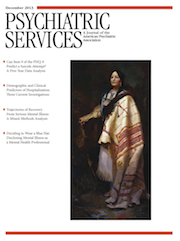Alternative Settings: Unintended Consequences
To the Editor: The November issue includes a timely review by Thomas and Rickwood (1) of residential alternatives to psychiatric hospitalization for patients who need acute care. Their main conclusion was that care provided in these settings can improve symptoms at least as well as care provided in psychiatric hospitals and that the alternative settings appear to be cost-effective. At a time when saving money is becoming increasingly important, it is essential to look closely at these findings. The authors noted the enormous variation among these services. They also remarked that the studies they reviewed did not provide much detail about the patients and the actual treatment and support provided. A recent review of nonresidential alternatives to psychiatric hospitalization also mentioned the omission of such details (2), and we agree with the authors that these aspects should be investigated further.
However, there is a point that was not emphasized by Thomas and Rickwood. Not only are details lacking about the patients and treatments, but virtually no information has been reported about what happens in the rest of the service system when a “crisis house” is introduced. Tyrer and colleagues (3) described the introduction of a home treatment team and mentioned that the number of suicides in the catchment area increased, although none of the patients who killed themselves were under the care of the home treatment team. It may have been the case that experienced staff had moved to the home treatment team and that community mental health teams thus became less effective. Something similar might happen with the introduction of crisis houses.
For economic evaluations of residential alternatives, it is also important to observe what happens in other parts of the system. For example, introduction of a home treatment team or a residential alternative may increase the number of empty hospital beds. Therefore, even though the alternative setting is cheaper per patient, the increased costs for the system of the empty beds may mean that offering care in the alternative setting is more expensive than offering standard inpatient care.
1 : Clinical and cost-effectiveness of acute and subacute residential mental health services: a systematic review. Psychiatric Services 64:1140–1149, 2013Link, Google Scholar
2 : Crisis resolution teams in the UK and elsewhere. Journal of Mental Health 21:285–295, 2012Crossref, Medline, Google Scholar
3 : Controlled comparison of two crisis resolution and home treatment teams. Psychiatrist 34:50–54, 2010Crossref, Google Scholar



